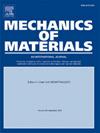线基激光定向能沉积制备SS316LSi的各向异性拉伸性能和微观结构
IF 3.4
3区 材料科学
Q2 MATERIALS SCIENCE, MULTIDISCIPLINARY
引用次数: 0
摘要
研究了激光线定向能沉积(LW-DED)制备的两种奥氏体不锈钢316LSi垂直壁构件的各向异性力学性能和显微组织。从这些双壁的不同位置提取ASTM标准拉伸试样。在单轴拉伸作用下,对试件纵向和横向相对于构建方向的力学性能进行了评估。选取一定数量的试样在1100℃下进行热处理,以评估其对各向异性、极限强度和延性的影响。采用数字图像相关(DIC)分析了两个具有代表性的水平和垂直试样的应变场演化。用扫描电子显微镜检查断裂表面。结果表明,试样在两个方向上的平均极限抗拉强度均为550 MPa,中间位置的试样的最大强度为680 MPa。这种变化是由于印刷壁的残余应力差异,经有限元分析证实。垂直和水平提取标本的平均伸长率分别为25%和35%。由于晶粒组织变粗,热处理使这两类材料的延展性都提高了15 - 20%。塑性的各向异性主要是由于柱状晶粒取向的差异,在水平提取的试样中,粗晶粒与拉伸方向排列。这种排列有利于损伤积累,导致拉伸断裂。本研究为LW-DED SS316LSi元件的各向异性行为以及热处理对拉伸性能的影响提供了见解。本文章由计算机程序翻译,如有差异,请以英文原文为准。
Anisotropic tensile properties and microstructure of SS316LSi fabricated using wire-based laser directed energy deposition
This paper investigates the anisotropic mechanical properties and microstructures of two austenitic stainless steel 316LSi vertical wall components fabricated using laser wire-directed energy deposition (LW-DED). ASTM standard tensile specimens were extracted from different locations of these twin walls. The specimens’ mechanical properties in longitudinal and transverse orientations relative to the build direction were assessed under uniaxial tension. A select number of speciments were subjected to heat treatment at 1100 oC to evaluate its impact on anisotropy, ultimate strength, and ductility. Digital image correlation (DIC) was employed to analyze strain field evolution in two representative horizontal and vertical specimens. Fractured surfaces were examined using scanning electron microscopy. The results showed an average ultimate tensile strength of 550 MPa in both directions, with a maximum strength of 680 MPa in specimens from the median location. This variation was attributed to residual stress differences across the printed wall, as confirmed by finite element analysis. The average elongations were 25 % and 35 % for vertically and horizontally extracted specimens, respectively. Heat treatment enhanced ductility by 15–20 % for both categories due to grain structure coarsening. The anisotropy in ductility was primarily because of the differences in columnar grain orientation with the coarser grains aligned with the tension direction in horizontally extracted specimens. This alignment facilitated damage accumulation, leading to tensile fracture. This study provides insights into the anisotropic behavior of LW-DED SS316LSi components and the influence of heat treatment on tensile properties.
求助全文
通过发布文献求助,成功后即可免费获取论文全文。
去求助
来源期刊

Mechanics of Materials
工程技术-材料科学:综合
CiteScore
7.60
自引率
5.10%
发文量
243
审稿时长
46 days
期刊介绍:
Mechanics of Materials is a forum for original scientific research on the flow, fracture, and general constitutive behavior of geophysical, geotechnical and technological materials, with balanced coverage of advanced technological and natural materials, with balanced coverage of theoretical, experimental, and field investigations. Of special concern are macroscopic predictions based on microscopic models, identification of microscopic structures from limited overall macroscopic data, experimental and field results that lead to fundamental understanding of the behavior of materials, and coordinated experimental and analytical investigations that culminate in theories with predictive quality.
 求助内容:
求助内容: 应助结果提醒方式:
应助结果提醒方式:


